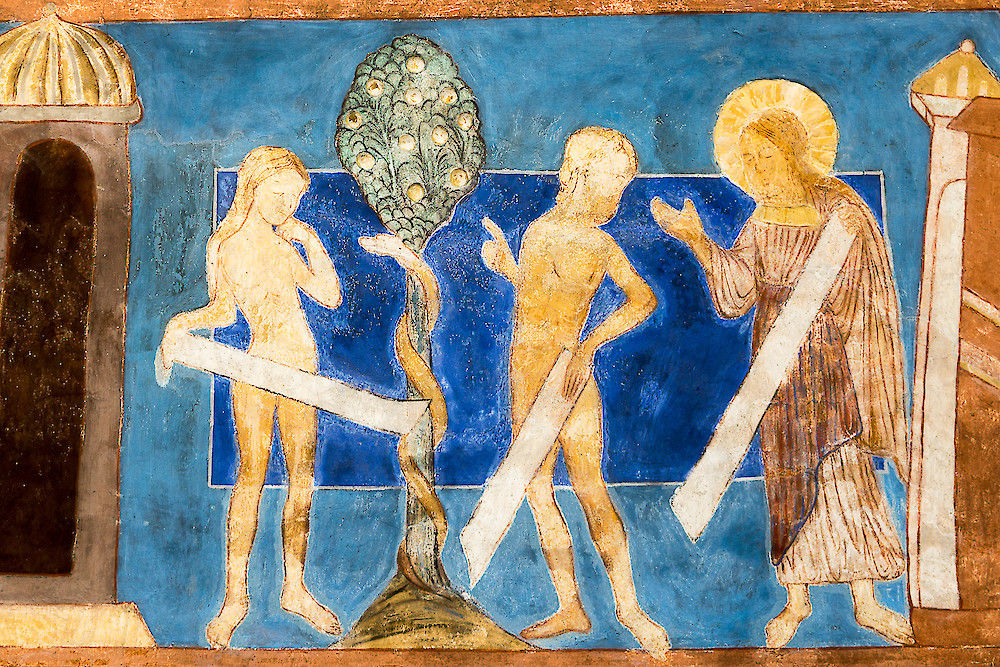Gender issues in the Bible

As the world becomes more diverse, our age-old barriers are being pulled down on topics like gender identity and sexual orientation. The queer movement is fighting for the social acceptance of individuals who identify outside the binary gender roles. Same-sex partnerships are becoming a natural part of open societies and have even become legally recognised in countries such as Germany.
However, the increasing fluidisation of gender identity is a controversial issue that is not always welcomed with open arms. The traditional roles assigned to men and women – and their institutionalised relationship in marriage as the foundation of social order – are often justified through the teachings of a higher authority: the Bible. After all, the following verse can be found in the Book of Genesis, the first book of the Pentateuch: “So God created man in his own image, in the image of God created he him; male and female created he them.”
The problem with such supposedly authoritative evidence in both religious and general social discourse is the fact that biblical quotes are often removed from their context to justify normative positions. But if we look at the Hebrew and Aramaic scriptures, the collection known today as the Old Testament, we find that the cultural models of gender roles, sexuality and relationships in the Bible are much more complex than commonly assumed.
This problem is even reflected by the quoted verse from the Book of Genesis, because it does not establish specific gender roles: The original Hebrew text does not refer to man and woman, but to two different primary sexual characteristics. Moreover, God is said to have created man as male and female (not explicitly as man or woman), which could be interpreted to mean the first person created by God united both male and female characteristics in one androgenous being.
These questions of interpretation might just be footnotes for some, but they were certainly not trivial 2,000 years ago. In the theological discourse of rabbinic Judaism after around 100 AD, the clear definition of sex played a much greater role than it does today, as men and women were subject to considerable differences in religious law, such as the content and form of their worship and purity requirements. The fact that negotiating the problem of ambiguous sexual characteristics at birth was so important suggests that such cases were not as rare as we commonly assume. The people of ancient Israel even had a separate term for individuals with no clear sexual identity: “androgynos”, which was loaned from Greek.
When studying scripture, it is essential that we examine the original sources and put the passages in their historical context. Even the assumption that God is male, which is often taken for granted and used as authoritative proof of male dominance, does not hold water when we look at the history of religion in Ancient Israel, because metaphorical references to God as a “suckling mother” and numerous depictions of a female Goddess suggest otherwise.
Furthermore, even apparently unambigious terms, functions and roles cannot simply be carried over to the present day. In the Hebrew biblical texts, for example, a “wife” is not seen as the equal partner of her husband, but as his property – after all, he had to pay good money as compensation for taking away a valuable worker from her father’s family. A woman’s birth rate was of great importance, but the reproductive role was ascribed to men. After all, they believed the child was only created in the sperm – the womb was merely a shelter for the growing embryo. This would explain why surrogacy was not uncommon in ancient Israel. Anyone who refers to the Bible to define the concept of modern marriage certainly does not have this image of womanhood in mind.
It is also important to note that the above is not only true of ancient Hebrew scriptures. Paul, whose epistles form an important part of the New Testament, condemns homosexuality but doesn’t think much of heterosexual relationships either: “It is good for a man not to touch a woman”, he writes in his First Epistle to the Corinthians. He continues: “From now on, even those who have wives should be as though they had none”. The image of marriage depicted here is rather misogynistic, anti-sexual and merely functional as opposed to a loving partnership.
However, there is no shortage of biblical texts where love and lust play a major role. The best-known example is undoubtedly the Song of Songs, a kind of drama with highly erotic content. This explicit love poetry portrays the highest forms of sexual desire and even delves into the woman’s perspective. Jewish scholars of antiquity argued intensively as to whether such passages could even be described as sacred at all. In the end, they proposed an allegoric interpretation of the Song of Songs – not as an erotic depiction of man and woman, but as God’s love for the people of Israel.
There are many such examples of contradiction and re-contextualisation. Therefore, we cannot expect the Bible as a whole to provide us with universal and normative answers on love, sexuality and partnership. When we read the ancient texts soberly in the contexts in which they were written, we find no clear condemnation of homosexuality or lust, no rigid gender identities and no clear role assignments for men and women. From a theological perspective, none of the arguments calls the canonical role of the Bible into question; instead, they should build an awareness of its diversity and depth of meaning.
Professor Stefan Schorch has been the Professor of Biblical Studies at the Theological Faculty of the MLU since the 2008/09 winter semester. His research areas include the Old Testament, Jewish literature of the Hellenistic and Roman periods, and Hebrew linguistics. He also directs the Samaritan Research Unit.
Professor Stefan Schorch
Institute of Biblical Studies
Telephone +49 345 55-23014
Mail: stefan.schorch@theologie.uni-halle.de


Kommentare
Marvin Wojtkowiak am 29.12.2021 11:17
Durchgängig findet die zu Beginn verurteilte Praxis Anwendung: Biblische Zitate werden aus dem Kontext gelöst, um die eigene Position zu rechtfertigen, sowie Gegenpositionen zu relativieren - Eine Glanzleistung!
So wird aus den beiden Menschen in Genesis, von denen im Kontext gesehen eindeutig von einem Mann und einer Frau gesprochen wird die Gott geschaffen hat (die nächsten 2 Kapitel zu lesen hilft für ein valides Verständnis durchaus weiter), plötzlich ein androgynes Wesen (von dem wir dann allerdings im Anschluss merkwürdiger Weise nichts mehr lesen). Aus zwei nur zur Hälfte zitierten Paulusversen wird Paulus unterstellt er sehe Ehe nur als frauen- und sexualfeindliche Zweckgemeinschaft (Im Kontext der Bibelstellen gelesen, wird auch hier wieder deutlich, dass diese Mutmaßung nicht annähernd trifft, was der Autor hier aussagen wollte).
Entschuldigen sie meine Polemik, ich bin innerlich sehr bewegt davon, aber gerade mit dem Anspruch der Wissenschaftlichkeit erwarte ich eine deutlich solidere exegetische Arbeit. Zumindest dann wenn der Schwerpunkt biblisch-theologisch ist. Anders wäre es bei einem sozialwissenschaftlichen Schwerpunkt gewesen.
Wie diese biblischen Texte letztlich zu verstehen sind und welche hermeneutischen Rückschlüsse aus einer sauberen Exegese und historischen Kontextanalyse zu ziehen sind, sei zunächst offen gelassen. Ich persönlich glaube unter Berücksichtigung der genannten Voraussetzungen wird es sicher für beide Seiten (Fraktionen) Überraschungen und neue Erkenntnisse geben.
Ich hoffe, dass diese Veröffentlichung noch einmal überarbeitet und auf ein solideres theologischen Fundament gestellt wird.
Mit freundlichen Segenswünschen!
Reply
dafur am 31.05.2023 12:41
Der Satz
"Schon mit dem zitierten Satz aus der Genesis ist das so eine Sache, weil er keine Geschlechterrollen begründet: Im hebräischen Original ist nämlich nicht von Mann und Frau die Rede, sondern von zwei Menschen mit unterschiedlichen primären Geschlechtsmerkmalen."
belegt schon einen Irrtum.
Im hebräischen Original ist nämlich genau von "MANN und FRAU" die Rede. Wörtlich, zwei Substantive. Mit "und".
Somit ist die Grundannahme in dem Artikel widerlegt.
Hier der hebräische Text interlinear übersetzt:
וַיִּבְרָ֨א אֱלֹהִ֤ים ׀ אֶת־הָֽאָדָם֙ בְּצַלְמֹ֔ו בְּצֶ֥לֶם אֱלֹהִ֖ים בָּרָ֣א אֹתֹ֑ו זָכָ֥ר וּנְקֵבָ֖ה בָּרָ֥א אֹתָֽם
Und schuf Gott (Elohim) DEN MENSCHEN (Substantiv mit Artikel; singular) in Seinem Bild - in dem Bild Gott(es) Er schuf ihn MANN (ein Substantiv) und FRAU (ein Substantiv)
Der hebr. Text sagt explizit, dass DER MENSCH als MANN und FRAU geschaffen wurde.
Reply
Stefan Schorch am 05.06.2023 15:53
Sehr geehrte/r "dafur",
wie in meinem Text dargelegt, beziehen sich die Ausdrücke "Mann" und "Frau" in Gen 1,27 auf die Unterscheidung verschiedener körperlicher Geschlechtsmerkmale, nicht auf Geschlechterrollen. Wenn in diesem Zusammenhang "der Mensch" (Singular!) als "Mann UND Frau" geschaffen wird, dann legt sich nach dem hebräischen Original das Verständnis nahe, daß es sich bei diesem Menschen um ein einziges Wesen handelt, das körperliche Mehrkmale beider Geschlechter hat, also androgyn ist. Mit anderen Worten: Das "UND", dessen Vorhandensein Sie zu Recht betonen, führt keineswegs eine Alternative ein ("ENTWEDER Mann ODER Frau"), wie Sie vorschlagen, sondern drückt aus, daß der soeben geschaffene Mensch GLEICHERMAßEN "Mann UND Frau" ist. Das ist übrigens keine Entdeckung von mir, sondern wurde bereits von der antiken jüdischen Bibelauslegung so erkannt.
Reply